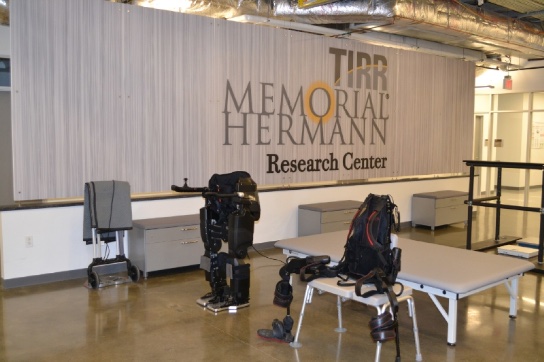Science Fiction Becomes Reality for MS Patients in New Robotic Exoskeleton Study

Wearable robotic exoskeletons may soon help people with advanced multiple sclerosis (MS) walk more efficiently and confidently again. Exoskeleton technology reduces the amount of energy and muscle exertion needed to initiate and control the process of walking, according to research presented last week at the Association for Academic Physiatrists (AAP) annual meeting in Sacramento, California. The AAP is the only academic association in the world dedicated to the specialty of physical medicine and rehabilitation (PM&R) — a community of physicians, researchers, in-training physiatrists, and others involved or interested in PM&R.
MS, afflicting an estimated 2.3 million people worldwide, is a chronic, currently incurable, and potentially disabling disease with an array of symptoms that often include leg numbness and weakness, tremors, diminished coordination, unsteady walking and, eventually, paralysis.
Once considered the stuff of science fiction, wearable exoskeletons are now poised to enter mainstream healthcare as rehabilitation tools that can enhance physical function and quality of life, and are designed to facilitate walking for people with neurological/neuromuscular disorders. However, few studies have been conducted to evaluate the degree of assistance exoskeletons can provide.
The study presented at the AAP meeting, “Metabolic Expenditures during Exoskeleton-Assisted Walking in Person with Multiple Sclerosis,” was co-authored by researchers representing The University of Texas Health Science Center at Houston (UTHealth), TIRR Memorial Hermann, and Texas Women’s University, and examined the feasibility and effectiveness of exoskeletons to assist persons with MS in walking as part of a study funded by the National Multiple Sclerosis Society.
The team notes that wearable exoskeletons are designed to be utilized to facilitate walking for individuals with neurological conditions such as spinal cord injury, but the amount of assistance provided during exoskeleton-assisted walking had not been quantified scientifically.
Researchers studied one subject, a 33-year-old woman with relapsing-remitting MS (RRMS) with an expanded disability status scale (EDSS) score of 6.0. She received 12 training sessions in exoskeleton-assisted walking using an EKSO wearable exoskeleton made by Ekso Bionics of Richmond, California. Outcome measures were taken after training with the device. Metabolic expenditures during a timed up-and-go test (TUG), a 25-foot walk test (25FTWT, self-selected and fast speed) and a 6-minute walk distance test (6MWT) were measured for exoskeleton-assisted walking and compared with measures taken during unassisted walking. Muscle activation profiles were also recorded and analyzed in major muscles of the upper and lower extremities using surface electromyography (sEMG).
The team reported that preliminary outcomes data showed maximal oxygen consumption (VO2max) and heart rate (HR) during the 6MWT (approximately 7.5 percent and 6 percent, respectively) were lower in exoskeleton-assisted walking than in unassisted walking. But in 25FTWT at fast speed, the VO2max and HR were higher (approximately 3 percent and 10 percent, respectively) in exoskeleton-assisted walking than in unassisted walking. For sEMG, all muscles of the lower extremities except the semitendinosus showed lesser activity during the 25FTWT at self-selected speed and the 6MWT in exoskeleton-assisted walking than in unassisted walking. Similar to the metabolic pattern observed, muscle activities were greater during the 25FTWT at fast speed in exoskeleton-assisted walking than in unassisted walking. The study subject also found it difficult to operate the exoskeleton when attempting the TUG test.
Overall, the investigators concluded that exoskeleton assisted walking may enable MS patients to walk more efficiently by reducing metabolic expenditures and muscle activity, especially over longer distances, and that wearable exoskeletons could also provide useful assistance to persons with MS in performing daily activities, leading to a better quality of life.
“Our study participant told me when she was in the study, ‘I am looking at the quality of the rest of my life, not quantity of the days I can live,'” the study’s lead investigator Shuo-Hsiu ‘James’ Chang, an assistant professor at UTHealth’s Neurorecovery Research Center at TIRR Memorial Hermann in Houston, Texas, said in a news release. “It is a strong message telling us that rehabilitation plays a critical role in helping people with MS to live better quality lives. I believe exoskeleton-assisted training and walking is one of the most effective strategies that can promote quality of life and community reintegration in this population.”
Dr. Chang, a physical therapist from Taiwan, holds an MS and PhD in Human Movement Science with a specialty in motor control and learning from The University of North Carolina at Chapel Hill. His research focus has been on neuromuscular plasticity and its underlying mechanisms, and the involvement of cortical and spinal circuitry in dynamic balance control, especially in maintaining balance or regaining balance from ‘unexpected perturbation.’ Dr. Chang is interested in developing effective interventions that can exercise paralyzed or weak muscle, and facilitate neuroplasticity at the spinal or cortical level. He has investigated the effects of lower limb exoskeleton locomotion training on gait in patients with spinal cord injuries, and collaborated with researchers from TWU and UTHealth in several motor control studies.

The NeuroRecovery Research Center, a new facility on the campus of TIRR Memorial Hermann, opened in early February 2016. The center, a collaborative project among clinicians, scientists and engineers, has the goal of finding breakthroughs that will take rehabilitation services to the next level. It is part of a more than 42,000 square-foot building devoted to new, innovative ways to treat and rehabilitate patients with a range of disabilities and conditions, such as brain and spinal cord injury, stroke, multiple trauma, amputation, and neurodegenerative diseases, and with capacity to house multiple labs conducting different studies and trials at the same time.
“The amount of collaboration that will go on among our teams is something that just can’t be beat,” Dr. Gerard E. Francisco, chief medical officer at TIRR Memorial Hermann, director of the NeuroRecovery Research Center and professor and chairman of Physical Medicine and Rehabilitation Department (PM&R) at McGovern Medical School at UTHealth, said in a UTHealth release. “We do research to answer real world clinical questions so we can do better in our clinical care.””This is an exciting time at TIRR as we take the research component of our rehabilitation services to the next level,” added Carl Josehart, TIRR Memorial Hermann’s senior vice president and CEO. “This state-of-the-art facility will provide researchers with the tools to pioneer new advances in rehabilitative medicine and get our patients back to the life they love.”
“To promote walking for people with MS, we need to be creative and develop novel strategies. Wearable exoskeletons offer the feasibility of assisted overground walking and may be effective assistance devices to promote efficient walking, and better quality of life,” said Dr. Chang, who notes that the wearable exoskeleton is one of the advanced technologies that could promote the effectiveness of rehabilitation strategies. “We need to conduct more studies, such as larger trials with larger populations … to perform a systematic investigation and analysis that studies effectiveness of exoskeleton-assisted rehabilitation in MS. In our research center, we have another ongoing exoskeleton study that is designed to develop an algorithmic-based evaluation and treatment approach for wearable exoskeleton-assisted rehabilitation that focuses on physiological changes and gait in patients with stroke, spinal cord injuries and MS. We expect the results will help us to understand better how we can utilize exoskeletons and design effective exoskeleton-assisted rehabilitation programs.”
Another, larger clinical trial led by Dr. Chang is currently underway and recruiting MS patients with an EDSS score between 6 and 7.5, inclusive, and sponsored by The University of Texas Health Science Center, Houston, in collaboration with The National Multiple Sclerosis Society and Texas Woman’s University. The goal of the study, “Wearable Lower Extremity Exoskeleton to Promote Walking in Persons With Multiple Sclerosis” (ClinicalTrials.gov identifier: NCT02519244), is to investigate the potential of a wearable robotic exoskeleton — again the Ekso wearable lower limb exoskeleton — to help people with MS to walk more naturally again.
Sources:
Association of Academic Physiatrists (AAP) Via Newswise and Science Daily
TIRR Memorial Hermann Health System
The NeuroRecovery Research Center
The University of Texas Health Science Center at Houston (UTHealth)
ClinicalTrials.gov
Ekso Bionics






